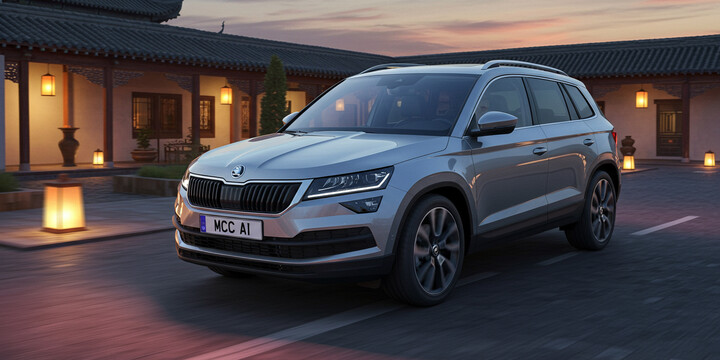
SKODA KAROQ (2017-22)
The SKODA KAROQ (2017-22) is a stylish and practical compact SUV that has gained popularity in the UK market, especially among families and commuters seeking a versatile vehicle. Known for its spacious interior, comfortable ride, and smart design, the KAROQ offers a great blend of practicality and modern features. It's often used for day-to-day driving, family outings, and longer trips, making it an ideal choice for those who need a dependable, stylish vehicle that can handle various road conditions.
With a reputation for reliability and good fuel economy, the SKODA KAROQ (2017-22) stands out in its class thanks to its practicality, quality build, and user-friendly technology. Its popularity is reflected in over 17,000 look-ups on MyCarCheck.com, with nearly 6900 different VINs recorded, showing a broad range of vehicles and owners. Typically, these cars are found with around 28,760 miles on the clock, having seen less than one previous owner on average. Whether you're a family needing space or someone looking for a dependable daily driver, the SKODA KAROQ (2017-22) remains a solid, well-regarded choice in the competitive SUV segment.

average use

The data indicates that the most common mileage range for the recorded SKODA KAROQ vehicles from 2017-22 is between 30,000 and 40,000 miles, comprising 19.3% of the sample. Notably, a significant number of vehicles are also found within the 40,000 to 50,000 miles range (17.8%) and 50,000 to 60,000 miles (12.8%). Lower mileage vehicles (0 to 10,000 miles) are relatively rare at just 4.7%, suggesting few recent low-mileage vehicles in this dataset. Conversely, high-mileage vehicles above 100,000 miles are quite uncommon, with percentages dropping below 2% beyond 110,000 miles. Overall, most vehicles tend to cluster within the 30,000 to 70,000-mile range, which might reflect typical usage patterns for this model.

vehicle values

The data on private sale valuations for the Skoda Karoq (2017-22) reveals that the most common price range is between £12,000 and £13,000, accounting for approximately 13.9% of valuations, followed closely by the £13,000 to £14,000 range at 13.6%. Notably, the highest percentage of valuations (11.9%) falls within the £10,000 to £11,000 bracket, indicating a strong market demand in that range. Conversely, the lowest percentages are observed at the higher end (£18,000 to £23,000), each representing less than 1% of valuations, suggesting that select high-value vehicles are relatively rare in private sales. Overall, the data indicates a concentration of private sale valuations in the £10,000 to £15,000 range, with diminishing frequencies at both lower and higher price points.

production years

The data indicates that the majority of Skoda Karoq vehicles from the 2017-2022 range were manufactured between 2018 and 2021, with 2018 accounting for approximately 30.9% of the vehicles and 2019 for about 27.6%. Vehicles from 2020 make up 22%, while those from 2021 comprise around 15.1%. Very few vehicles from 2017 (0.6%) and 2022 (3.9%) are present in the sample, suggesting that newer models and those from the latest year are less prevalent, possibly due to market availability or attrition over time. Overall, the data shows a healthy distribution across recent years, with a notable concentration in the 2018-2021 period.

colour popularity

The data indicates that among Skoda Karoq models produced between 2017 and 2022, grey is the most common main exterior colour, accounting for 36.2% of vehicles. Blue is also quite popular, representing 24%. Other notable colours include white (12.8%) and black (11%). Less frequently chosen shades are silver (6.5%), green (5.6%), and red (3%). Very rare colours such as yellow, beige, and brown each make up just 0.3%. Overall, these insights suggest that neutral and conservative colours dominate the palette for this model, with a few more vibrant options like blue and green making up a significant portion of the offerings.

ownership cycle

The data indicates that for the SKODA KAROQ (2017-22), the majority of vehicles have had two or three registered keepers, accounting for roughly 74.2% combined (48.1% with two keepers and 26.1% with three). Notably, a significant portion, 16%, have only had a single registered keeper, suggesting some vehicles may have been owned by the original purchaser or kept for longer periods without changing hands. Smaller percentages of vehicles have had four or more keepers, with the rarest being eight or more keepers at only 0.3%. Overall, the data points to a relatively steady ownership pattern with most vehicles remaining with a small number of owners over their lifespan.

engine choices

The data for Skoda Karoq models (2017-22) shows that the most common engine capacity is 1498cc, accounting for nearly half (49.9%) of the vehicles. The 1968cc engines are also notable at 14.5%, alongside smaller 999cc (14.8%) and 1598cc (18.1%) engines. A smaller portion, 2.7%, has a 1984cc engine capacity. Regarding fuel types, approximately two-thirds (67.4%) of these vehicles run on petrol, while about one-third (32.6%) are diesel. This indicates that petrol models are predominant in the range, with the 1498cc petrol engines being particularly common among these vehicles.












